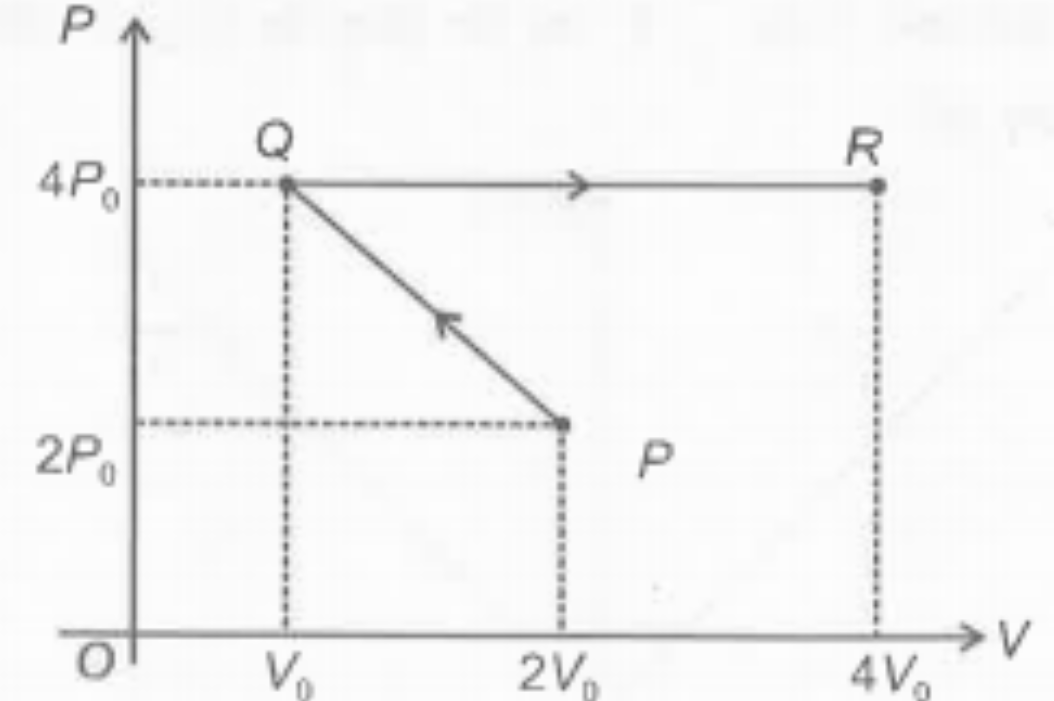Pi,Viare initial pressure and volumes and Vf is final volume of a gas in a thermodynamic process respectively. If PVn= constant, then the amount of work done by gas is:(γ=Cp/Cv). Assume same, initial states & same final volume in all processes.
minimum for n=γ
minimum for n=1
minimum for n=0
minimum for n=1γ
The correct Answer is:A
To solve the problem, we need to find the amount of work done by a gas in a thermodynamic process where the relationship between pressure (P) and volume (V) is given by the equation PVn=constant. We are interested in determining the value of n for which the work done is minimized.
1. Understanding the Equation:
The equation PVn=C (where C is a constant) implies that pressure and volume are related in a specific way. We can express pressure as:
P=CVn
2. Work Done by the Gas:
The work done W by the gas during expansion or compression from an initial volume Vi to a final volume Vf can be calculated using the integral:
W=∫VfViPdV
Substituting for P:
W=∫VfViCVndV
3. Integrating:
The integral can be solved as follows:
W=C∫VfViV−ndV=C(V1−n1−n)VfVi(for n≠1)
Evaluating the integral gives:
W=C1−n(V1−nf−V1−ni)
4. Special Case for n=1:
If n=1, the equation becomes:
W=C∫VfVi1VdV=C(lnV)VfVi=Cln(VfVi)
5. Analyzing Work Done:
To find the value of n that minimizes the work done, we need to analyze the expression for W derived above. The work done is a function of n and depends on the values of Vi and Vf.
6. Graphical Representation:
By plotting P vs. V for different values of n, we can visualize how the area under the curve (which represents work done) changes:
- For n=0, the graph is a horizontal line (constant pressure).
- For n=1, it is a rectangular hyperbola.
- For n=γ (where γ=CpCv>1), the curve is steeper.
7. Conclusion:
The area under the curve (work done) is maximized for n=0 and minimized for n=γ. Thus, the amount of work done by the gas is minimum when:
n=γ
Final Answer:
The amount of work done by the gas is minimum for n=γ.
The equation PVn=C (where C is a constant) implies that pressure and volume are related in a specific way. We can express pressure as:
P=CVn
The work done W by the gas during expansion or compression from an initial volume Vi to a final volume Vf can be calculated using the integral:
W=∫VfViPdV
Substituting for P:
W=∫VfViCVndV
The integral can be solved as follows:
W=C∫VfViV−ndV=C(V1−n1−n)VfVi(for n≠1)
Evaluating the integral gives:
W=C1−n(V1−nf−V1−ni)
If n=1, the equation becomes:
W=C∫VfVi1VdV=C(lnV)VfVi=Cln(VfVi)
To find the value of n that minimizes the work done, we need to analyze the expression for W derived above. The work done is a function of n and depends on the values of Vi and Vf.
By plotting P vs. V for different values of n, we can visualize how the area under the curve (which represents work done) changes:
- For n=0, the graph is a horizontal line (constant pressure).
- For n=1, it is a rectangular hyperbola.
- For n=γ (where γ=CpCv>1), the curve is steeper.
The area under the curve (work done) is maximized for n=0 and minimized for n=γ. Thus, the amount of work done by the gas is minimum when:
n=γ
The amount of work done by the gas is minimum for n=γ.
Topper's Solved these Questions
- KTG & THERMODYNAMICSBOOK - RESONANCE ENGLISHCHAPTER - KTG & THERMODYNAMICSEXERCISE - PART -III
25 Videos
- KTG & THERMODYNAMICSBOOK - RESONANCE ENGLISHCHAPTER - KTG & THERMODYNAMICSEXERCISE - PART -IV
9 Videos
- KTG & THERMODYNAMICSBOOK - RESONANCE ENGLISHCHAPTER - KTG & THERMODYNAMICSEXERCISE - Exercise-2
1 Videos
- KINETIC THEORY OF GASES AND THERMODYNAMICSBOOK - RESONANCE ENGLISHCHAPTER - KINETIC THEORY OF GASES AND THERMODYNAMICSEXERCISE - Exercise
64 Videos
- MAGNETIC FIELD AND FORCESBOOK - RESONANCE ENGLISHCHAPTER - MAGNETIC FIELD AND FORCESEXERCISE - Exercise
64 Videos
Similar Questions
The pressure p and volume V of an ideal gas both increase in a process.
View SolutionThe pressure P and volume V of an ideal gas both decreases in a process.
View SolutionA sample of an ideal gas with initial pressure 'P' and volume 'V' is taken through an isothermal process during which entropy change is found to be DS. The work done by the gas is
View SolutionAn ideal monoatomic gas follows a thermodynamic process as shown in pressure-volume (P-V) plot. The work done in process AB is

View SolutionIn a process on a system, the initial pressure and volume are equal to final pressure and volume, then
View SolutionPressure and volume of a gas changes from (p0V0) to (p04,2V0) in a process pV2= constant. Find work done by the gas in the given process.
View SolutionAn ideal gas (Cp/Cv=γ) having initial pressure P0 and volume V0 (a) The gas is taken isothermally to a pressure 2P0 and then adiabatically to a pressure 4P0. Find the final volume. (b) The gas is brought back to its initial state. It is adiabatically taken to a pressure 2P0 and then isothermally to a pressure 4P0. Find the final volume.
View SolutionAn ideal gas undergoes a process P→Q→R as shown in pressure (p) - volume (v) diagram.The work done by the gas is

View SolutionA gas undergoes a process in which its pressure P and volume V are related as VPn= constant. The bulk modulus of the gas in the process is:
View SolutionAssertion: In a thermodynamic process, initial volume of gas is equal to final volume of gas. Work done by gas in this process should be zero
Reason: Work done by gas in isochoric process is zero.
View Solution
